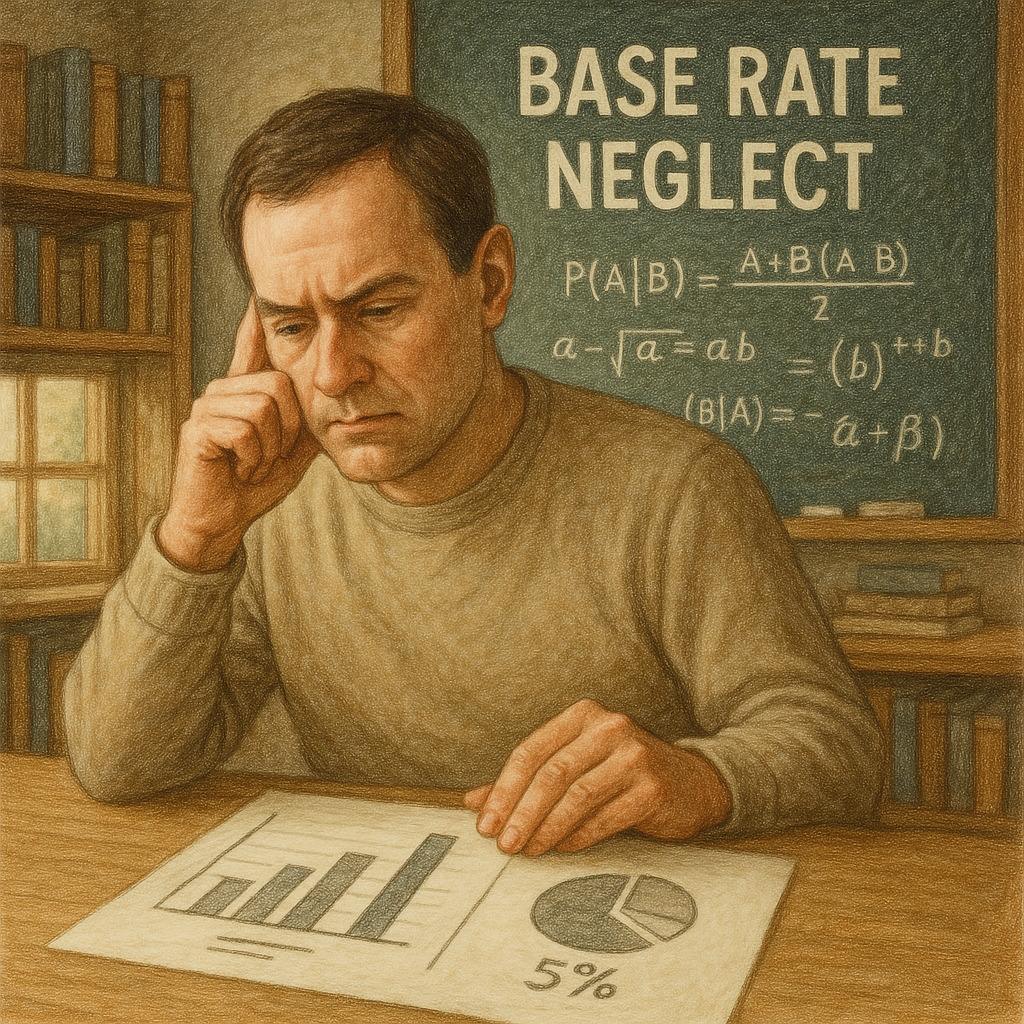Have you ever trusted a vivid story more than cold, hard statistics? You’re not alone. The base rate neglect mental model explains why we often overlook broad statistical information in favor of flashy details. Imagine this: A medical test is 80% accurate, and you test positive.
But if the disease only affects 1% of people, your actual risk is under 8%. Yet most people panic, ignoring the bigger picture and falling into the base rate fallacy.
This thinking trap affects decisions everywhere. In courtrooms, jurors might focus on emotional testimony instead of crime statistics. In sports, coaches could prioritize a player’s recent streak over their career averages. Even doctors sometimes misjudge test results by forgetting false positive rates, illustrating the biases that come with ignoring base rates.
Why does this happen? Our brains love stories. Specific details feel real, while numbers seem abstract. Nobel winner Daniel Kahneman calls this the “what you see is all there is” flaw.
But awareness changes everything. By learning to balance anecdotes with evidence, we make smarter choices in health, money, and relationships, avoiding the base rate fallacy in our judgment.
Key Takeaways
- We often ignore statistical odds when vivid stories grab our attention, illustrating the base rate fallacy.
- Medical test results frequently get misinterpreted without context, leading to biases in assessment.
- Legal decisions can be swayed by emotional details over crime data, showcasing how people can ignore base rates.
- Sports analytics show why career trends matter more than single games, providing a case for understanding base rates.
- Always ask: “What’s the bigger picture before I react?”
Understanding Base Rate Neglect and Its Impact
Ever made a choice because one story stuck in your mind, even when numbers suggested otherwise? That’s base rate neglect mental model in action. First studied by author Daniel Kahneman and Amos Tversky, this bias highlights the base rate fallacy, making us focus on vivid details instead of broader patterns.
Their famous Tom W. experiment provided a case example of how people guessed a student’s major based on personality traits—ignoring enrollment statistics entirely.
Why Stories Beat Spreadsheets
Our brains evolved to prioritize concrete details over abstract data. Think of it like this: Hearing “This medicine cured my aunt!” feels more convincing than reading a 95% success rate. Specific examples create emotional hooks, while percentages seem distant. Research from early studies reveals we process anecdotes 3x faster than statistical facts.
When Numbers Disappear
Here’s where mistakes happen:
| Situation | Ignored Data | Common Error |
|---|---|---|
| Medical Testing | Disease prevalence rates | Overestimating positive results |
| Facial Recognition | Population base rates | False identifications |
| Legal Decisions | Crime statistics | Misjudging guilt likelihood |
Notice a pattern? We’re great at spotting details but terrible at context. Next time you face a big decision, ask: “What’s the background data I might be missing?” It could change everything.
Real-Life Examples and Case Studies

What if your gut feeling led you astray, even with clear numbers in front of you? Let’s explore how this plays out in courtrooms, clinics, and coffee shops.
When Numbers Get Ignored
Take breathalyzer tests. A device might be 95% accurate. But if only 2% of drivers are drunk, most positive results are false alarms. This is a classic example of the base rate mental model. Yet officers—and jurors—often treat every reading as ironclad proof.
In the O.J. Simpson trial, lawyers focused on specific evidence like glove fit. Broader information about domestic violence patterns? Rarely discussed. This spotlight effect skews judgments, illustrating how people can fall victim to the base rate fallacy.
| Situation | Ignored Data | Outcome |
|---|---|---|
| Disease Screening | 1% infection rate | 90% false positives |
| Police Stops | Neighborhood crime stats | Biased profiling |
| Career Guesses | Job market ratios | Wrong assumptions |
Mistakes at The Grocery Store
Ever thought “This cashier seems rude—must be a bad day”? Maybe. But what if they’ve handled 200 pleasant customers before you? We judge single interactions harder than overall patterns, which is a classic example of the base rate fallacy in action.
Teachers face this too. A student’s one bad test often overshadows their year-long progress, illustrating how the base rate fallacy can mislead our perceptions. It’s like yelling at a GPS for missing one turn during a 500-mile trip.
Spot the trap next time: “Am I focusing on one leaf instead of the whole tree?” Your answer could prevent costly errors in judgment, highlighting the importance of understanding base rate information.
Psychological Perspectives and Research Findings
Why do we keep making the same thinking mistakes even when we know better? Behavioral scientists like Daniel Kahneman uncovered how our brains prioritize shortcuts over accuracy in processing information.
Their work shows we’re wired to grab quick answers—even when they’re wrong, similar to how software can misinterpret data based on the input it receives from people.
Insights from Behavioral Science and Daniel Kahneman
Kahneman’s famous “lawyer vs. engineer” experiment reveals a key flaw. Participants guessed someone’s job based on personality traits, ignoring that 70% were engineers.
This representativeness heuristic makes us favor stereotypes over stats, particularly when it comes to how we perceive information about people. Like assuming a quiet person loves math—without checking actual odds.
Another study tested witness reliability after a car accident. Even with an 85% blue cab rate in the city, people believed a green cab caused the crash because a witness said so.
The correct probability was 41%, but most guessed 80%. This shows how easily we dismiss background information and data.
Our brains treat vivid details like neon signs. Numbers? They’re background noise. As Kahneman notes in this research paper, “We see the world through story-shaped holes.” Ever felt certain about a choice that later backfired? That’s your brain choosing drama over data.
Three cognitive traps to watch:
- Snap judgments about people’s jobs or trustworthiness
- Overvaluing eyewitness accounts in legal settings
- Assuming rare events are common because they feel memorable
How to Apply The Base Rate Neglect Mental Model

How often do you make choices using partial information? Let’s fix that. Here’s a simple way to blend stats with stories for smarter results.
Step-by-Step Guidance for Better Decision-Making
1. Find the background odds first: Before reacting to news, ask: “How common is this overall?” If your friend tests positive for a rare disease, check how many actually have it in your area. A 1% infection rate changes everything.
2. Convert percentages to real numbers: Instead of “95% accurate,” think “5 errors in 100 tests.” When a recruiter says “Top 10% of candidates,” ask: “Is that 10 out of 100 or 100 out of 1,000?”
| Situation | Common Error | Smart Fix |
|---|---|---|
| Medical Results | Panicking over positives | Check population data first |
| Job Hiring | Overvaluing one interview | Review 3-year performance |
| Sports Drafts | Drafting based on 1 game | Analyze 50-game averages |
3. Play devil’s advocate: Ask: “What would change if the opposite were true?” If a weather app says 90% rain chance but skies are clear—check historical accuracy for your zip code.
Ever bought a “miracle” product because three friends loved it? That’s the fallacy of small samples. Always ask: “Is this typical, or just loud exceptions?”
Ready to test this approach? Next time you hear alarming news, pause. Whisper: “What’s the bigger story here?” Your future self will thank you.
Base Rate Neglect Pitfalls and How to Avoid Them

Ever made a snap judgment that later backfired? Our brains play tricks by spotlighting vivid details while hiding crucial background data. Let’s uncover these hidden traps—and learn to dodge them.
Spotting Hidden Traps
Bias triggers lurk in surprising places. At work, managers might promote someone based on one great project—ignoring their three-year track record and the critical information that could inform their decision. At home, parents could fixate on a child’s single bad grade rather than their overall progress.
Three sneaky scenarios where base rates vanish:
| Situation | Missing Data | Result |
|---|---|---|
| Health Screenings | Disease frequency | False alarm panic |
| Job Interviews | Industry turnover rates | Bad hires |
| Stock Picks | Market history | Risky investments |
Flipping the Script
Try these simple fixes:
1. Play detective first: Before reacting to news, ask: “What’s the normal rate here?” If a COVID test says positive but cases are low in your area, your actual risk might be 1 in 10.
2. Use time as your ally: Wait 24 hours before big decisions. Our brains process stats better when not flooded with emotions.
3. Hunt for opposites: If three coworkers love a new policy, ask: “How many dislike it quietly?” Silent majorities often hold key insights.
Remember that breathalyzer example? Officers using current DUI rates make fewer false arrests. What other thinking traps might be tripping you up? Tonight, reflect: When did you last ignore the bigger picture—and what cost did it carry?
Integrating Base Rate Information into Decision-Making

Ever bought a product because three friends raved, ignoring 1-star reviews? Blending hard numbers with personal stories takes practice—but pays off. Let’s explore how professionals balance these elements daily.
Balancing Statistical Data with Individuating Information
Doctors face this challenge constantly. A mammogram shows abnormalities, but breast cancer only affects 1.3% of women under 50. Research shows physicians often overestimate risk by 75% when forgetting this background rate. The fix? Compare test results to population data first.
Lawyers use similar strategies. In the famous taxicab identification study, witnesses claimed 80% accuracy identifying a blue cab. But since only 15% of cabs were blue, the real probability was 41%. Successful attorneys always check crime statistics before arguing cases.
| Do’s | Don’ts |
|---|---|
| Start with industry averages | Trust single data points |
| Use natural frequencies (e.g., “1 in 200”) | Rely solely on percentages |
| Update stats quarterly | Use outdated benchmarks |
SaaS companies show this balance in action. When forecasting sales, they combine:
- Historical conversion rates (broad data)
- Current client feedback (specific insights)
One CEO shared: “We achieved 92% accuracy by weighting general trends 70% and new testimonials 30%.” Could this ratio work for your next big decision?
Here’s your cheat sheet: Next time you get surprising news, ask: “How common is this normally?” Then adjust your view like tuning a radio—background static first, clear signal second.
Conclusion
The base rate neglact mental model reveals a powerful truth: background odds matter. The Sally Clark tragedy—where courts ignored infant mortality statistics—shows what happens when we let single events drown out broader patterns. Doctors misdiagnose patients, investors chase trends, and jurors convict innocents using the same flawed logic.
Here’s the good news: You can spot this thinking trap. Before trusting a “miracle cure” or job candidate’s perfect interview, ask: “What’s the normal success rate here?” Vaccine hesitancy crumbles when people check actual side effect frequencies. Stock picks improve when reviewing decade-long market cycles.
Keep these tools handy:
• Verify population data before reacting
• Convert percentages to real numbers (“1 in 200” vs. “0.5%”)
• Question vivid stories that feel too perfect
Your choices grow sharper when you blend human experiences with cold, hard math. Ready to see the world through clearer eyes? Next time you face a tough call, whisper: “What would the numbers say?” Your future self might just thank you.


